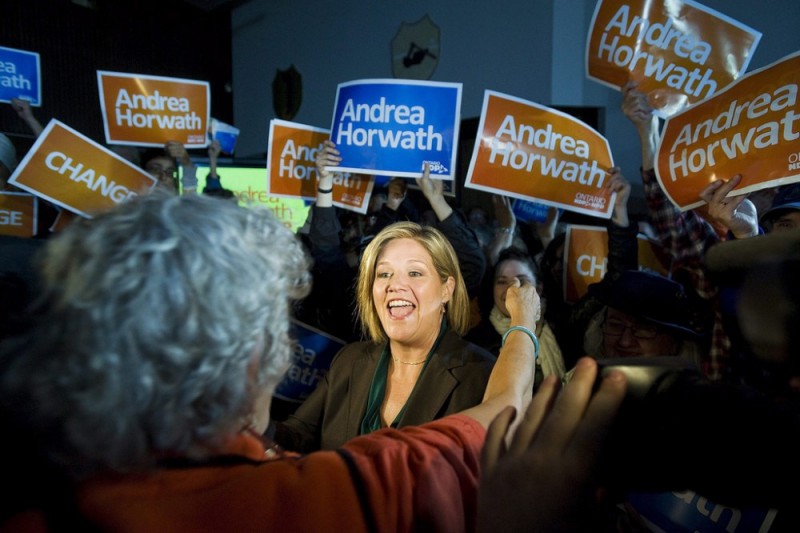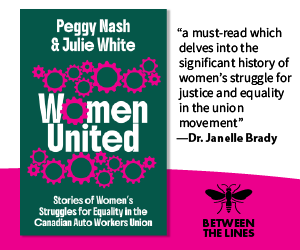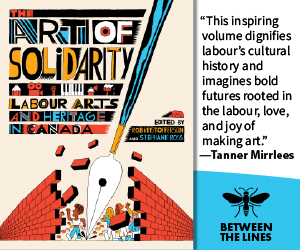The 2017 Ontario NDP convention: Lessons learned, steps forward

NDP leader Andrea Horwath greets supporters at a campaign rally in Toronto. Photo by Heather McCall.
In June 2014, The Ontario NDP wrapped up a fairly disappointing election. While the results on the surface were acceptable for Andrea Horwath and the ONDP—maintaining their 2011 seat total, and adding one percent of the popular vote—the end result was a Liberal majority government built on the relative collapse of Progressive Conservative support, which was driven by strategic voters looking to reject the politics of extreme austerity.
In the minds of many progressives, Horwarth and the party brass lost the ONDP’s balance of power by failing to offer a staunchly progressive vision, by not resonating with various social movements, and by releasing policy pieces and the overall platform far too late in the game. Some felt that, because the ONDP didn’t offer a compelling reason to support them, the AB(p)C voting constituency drove their support to the Liberals—who at least ostensibly—offered a progressive veneer, and who were in a better position to reap the rewards of our First-Past-the-Post electoral system.
On the whole, then, there was disappointment from within the ONDP membership going into the November 2014 convention, where Horwath was facing a leadership review many expected to be a nail-biter. And though she kept her job with the support of nearly 77 percent of the delegation, there remained a sense that an opportunity was lost in 2014, and that the next time around, things would need to be different on both ideological and strategic grounds. The failure of the federal NDP in 2015 likely underlined the same lessons.
And to Horwath and her team’s credit, things did change. On the administrative end, she brought in a new chief of staff; the party has worked hard to pay off their debt; it has undertaken new policies to enhance the financial autonomy and fundraising capacity of riding associations, and it has found a way to preserve the institutional relationship with organized labour based on a new model now that per capita affiliations and direct donations are no longer permissible.
And on the policy front, the ONDP has been more proactive and progressive. Not only has the party been rolling out policy for the 2018 election more than 18 months out—rather than leaving major promises for the middle of the campaign—but those promises have been better attuned to the realities of working and marginalized peoples in Ontario. This includes the ONDP’s support for a 15 dollar minimum wage, as well as for card-check certification and first contract arbitration. This also includes a more vocal fight against racism, islamophobia, and misogyny (on the last front, Horwath was the only major party leader in Ontario to attend the women’s march in response to Donald Trump’s inauguration). This is all on top of the ONDP’s fight on the Hydro portfolio, both in addressing how increased costs have hurt regular Ontarians and small businesses, but also in Horwath’s commitment to bring much of the system back into public control.
And as we came to the 2017 ONDP convention, the energy was altogether more positive, more unified, and more focused. Debates were still passionate—and delegates from across the province made eloquent points about how current ONDP policy directions still have much room to improve—but the general tenor was one of optimism. This was reflected not only in the convention floor’s tone, but in the 89% support Horwath obtained from the delegates. In this context came one of the ONDP’s biggest promises of the pre-campaign period: a commitment to launch a universal provincial pharmacare program. While details are still being formulated, the plan will be rolled out gradually, starting with commonly-prescribed medications, and with the eventual goal to offer comprehensive coverage.
We’re still a ways away from the 2018 election, and much can change before then, but the lessons of the last provincial and federal elections seem to have been absorbed. Principally, the reality is that while Liberal platforms are never in reality to the left of NDP platforms, when the NDP preaches moderation and caution, they lend such claims validity, which also lends credence to ABC voting. While we can expect the Ontario Liberals to co-opt some of these ONDP policies, the entire suite is far too consistently progressive for the Liberals to accept. In this sense, the ONDP might be set up for a scenario in which they are seen as the credible left-of-centre option strategically, with a platform that can’t be readily absorbed by the Liberals.
The challenge, of course, will be selling this bold programme to Ontario voters, which may well require tax increases of various sorts. Here, the party needs to treat voters with honesty, noting that while some of these plans may have significant costs, they are imperative to the social, economic, and physical infrastructure of our province. If taxes need to be increased, we need to be clear about this, and not act as the federal party did in 2015, where small tax increases, a zero deficit promise, and major program creation were all paired together.
But 2018 is a fantastic opportunity, and it appears as if the party is laying the ground work to offer to leftists of various banners something to support.
Christo Aivalis, a member of the CD web committee, is an adjunct professor of history at Queen’s University. His dissertation examined Pierre Trudeau’s relationship with organized labour and the CCF-NDP, and has been accepted for publication with UBC Press. His work has appeared in the Canadian Historical Review, Labour/le Travail, Our Times Magazine, Ricochet and Rankandfile.ca. He has also served as a contributor to the Canadian Press, Toronto Star, CTV and CBC. His current project is a biography of Canadian labour leader A.R. Mosher.










